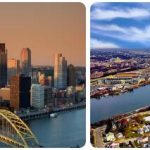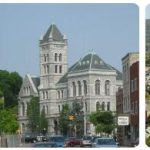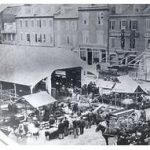Introduction
Philadelphia, city in the United States of America, in the state of Pennsylvania, at the mouth of the Schuylkill in the Delaware, with 1.5 million inhabitants. (agglom.: approx. 5.9 million inhabitants).
Philadelphia is one of the largest five cities in the country by population and is a major industrial, commercial, service and cultural center
Functions
Industry, which in the past made the city one of the most important industrial centers of the United States, still employs about 20% of the working population. An important pillar of the urban economy is the service sector, especially health care, education, tourism and personal services. Although the city is located about 120 km from the coast, it has a very important port accessible to seagoing vessels; the port is one of the largest freshwater ports in the world and is the second largest port (after New York) in the United States.
In addition to petroleum refining, the petrochemical industry and shipbuilding, the textile and steel industry, the manufacture of locomotives, medical equipment and electronics, as well as the printing industry are particularly important. Philadelphia has traditionally occupied a prominent place in money traffic (oldest federal currency, 1793) and a number of large banking institutions have their headquarters there. Philadelphia is connected by bridges to the cities of Palmyra, Gloucester City and Camden on the other side of the Delaware.
The city has several airports (including an international airport) and is an important hub for road and rail traffic. Philadelphia is the seat of a Roman Catholic Archbishop and has many institutions of secondary, higher and vocational education, including the University of Pennsylvania (1740), Temple University (1884), Drexel University (1891), several medical and theological colleges, an Academy of Fine Arts and the Curtis Institute of Music. Also of scientific significance are the Academy of Natural Sciences, dating from 1812 (with a collection of birds and insects), the Franklin Institute (industrial and technical research; with museum [1824] and Fels planetarium).
Among the museums are the Museum of the Academy of Fine Arts (1805; 18th-20th-century American painting, with important archive), the Philadelphia Museum of Art (1876; European, American and Oriental art) located in Fairmount Park., the University Museum (1887; archeology), the Atwater Kent Museum (local history), the Rodin Museum, a maritime museum, the Museum of the Historical Society of Pennsylvania (documents and artifacts from the colonial era), and the Institute of Contemporary Art. Important for musical life is the internationally renowned Philadelphia Orchestra; performances take place in the monumental Academy of Music, built in 1854 and inspired by the Scala of Milan. Numerous theater premieres are held in Philadelphia as a test for Broadway (New York) productions.
The 3,200-hectare Fairmount Park along the Schuylkill has important recreational functions with a zoo (the oldest in the United States), a botanical garden and various old buildings (mainly 18th century) spread over the site, which have been moved here from elsewhere.
Cityscape
Built on a diamond-shaped street plan after 1682, Philadelphia preserves more memories of the past than any other city in the United States. Independence Square (c. 1730) is part of Independence National Historical Park, which also houses Independence Hall (1732), with the liberty bell announcing the signing of the United States Declaration of Independence, which took place here.
The square is lit by 56 gas lamps, one for each signatory. On either side of Independence Hall are Congress Hall and the Supreme Court Building. Carpenters Hall (1770) hosted the first Continental Congress. Benjamin Franklin is buried in Christ Church (1727). Other old churches are the Old Saint Mary (1763, enlarged 1810), the St. George (1769), the oldest Methodist church in permanent use, and the Gloria Dei from 1700. The town also preserves a number of streets such as Elfreth’s Alley, with old houses; some of these are open to the public on certain days.
The cityscape is dominated by the City Hall with its 167 m high tower on which a statue of William Penn. The historic buildings, which include Old Custom House (1819-1824), in neoclassical style, are largely preserved. On the other hand, new construction is taking place on a large scale. In the northern part of Germantown are many old houses and a museum of old utensils.
History
Philadelphia was founded in 1682 by William Penn and a group of Quakers. In 1776 the Declaration of Independence was proclaimed; in 1787 the ratification of the first American Constitution took place.
The city was the capital of the United States from 1775 to 1789 and again from 1799 to 1800. From 1777 to 1778 it was in the hands of the British. In the American Civil War, Philadelphia, especially under the influence of the Quakers and against its own commercial interests, strongly supported the northern states.




